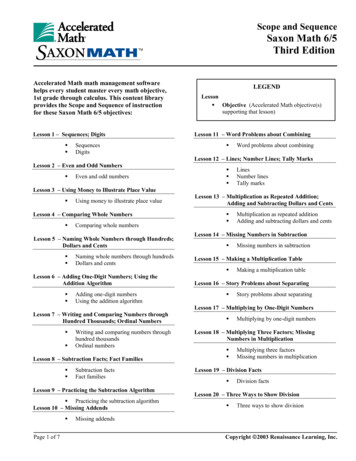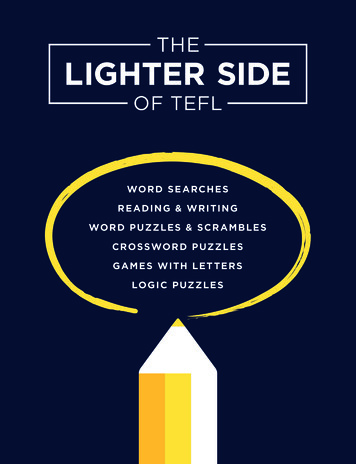
Transcription
Extracted from:Practical Programming, Third EditionAn Introduction to Computer Science Using Python 3.6This PDF file contains pages extracted from Practical Programming, Third Edition,published by the Pragmatic Bookshelf. For more information or to purchase apaperback or PDF copy, please visit http://www.pragprog.com.Note: This extract contains some colored text (particularly in code listing). Thisis available only in online versions of the books. The printed versions are blackand white. Pagination might vary between the online and printed versions; thecontent is otherwise identical.Copyright 2017 The Pragmatic Programmers, LLC.All rights reserved.No part of this publication may be reproduced, stored in a retrieval system, or transmitted,in any form, or by any means, electronic, mechanical, photocopying, recording, or otherwise,without the prior consent of the publisher.The Pragmatic BookshelfRaleigh, North Carolina
Practical Programming, Third EditionAn Introduction to Computer Science Using Python 3.6Paul GriesJennifer CampbellJason MontojoThe Pragmatic BookshelfRaleigh, North Carolina
Many of the designations used by manufacturers and sellers to distinguish their productsare claimed as trademarks. Where those designations appear in this book, and The PragmaticProgrammers, LLC was aware of a trademark claim, the designations have been printed ininitial capital letters or in all capitals. The Pragmatic Starter Kit, The Pragmatic Programmer,Pragmatic Programming, Pragmatic Bookshelf, PragProg and the linking g device are trademarks of The Pragmatic Programmers, LLC.Every precaution was taken in the preparation of this book. However, the publisher assumesno responsibility for errors or omissions, or for damages that may result from the use ofinformation (including program listings) contained herein.Our Pragmatic books, screencasts, and audio books can help you and your team createbetter software and have more fun. Visit us at https://pragprog.com.The team that produced this book includes:Publisher: Andy HuntVP of Operations: Janet FurlowManaging Editor: Brian MacDonaldSupervising Editor: Jacquelyn CarterDevelopment Editor: Tammy CoronIndexing: Potomac IndexingCopy Editor: Liz WelchLayout: Gilson GraphicsFor sales, volume licensing, and support, please contact support@pragprog.com.For international rights, please contact rights@pragprog.com.Copyright 2017 The Pragmatic Programmers, LLC.All rights reserved.No part of this publication may be reproduced, stored in a retrieval system, or transmitted,in any form, or by any means, electronic, mechanical, photocopying, recording, or otherwise,without the prior consent of the publisher.Printed in the United States of America.ISBN-13: 978-1-6805026-8-8Encoded using the finest acid-free high-entropy binary digits.Book version: P1.0—December 2017
From email clients and web browsers to calendars and games, text plays acentral role in computer programs. This chapter introduces a non-numericdata type that represents text, such as the words in this sentence or thesequence of bases in a strand of DNA. Along the way, we will see how to makeprograms a little more interactive by printing messages to our programs’ usersand getting input from them.Creating Strings of CharactersComputers may have been invented to do arithmetic, but these days, mostof them spend a lot of their time processing text. Many programs create text,store it, search it, and move it from one place to another.In Python, text is represented as a string, which is a sequence of characters(letters, digits, and symbols). The type whose values are sequences of characters is str. The characters consist of those from the Latin alphabet found onmost North American keyboards, as well as Chinese morphograms, chemicalsymbols, musical symbols, and much more.In Python, we indicate that a value is a string by putting either single ordouble quotes around it. As we will see in Using Special Characters in Strings,on page 8, single and double quotes are equivalent except for strings thatcontain quotes. You can use whichever you prefer. (For docstrings, the Pythonstyle guidelines say that double quotes are preferred.) Here are two examples: 'Aristotle''Aristotle' "Isaac Newton"'Isaac Newton'The opening and closing quotes must match: 'Charles Darwin"File " stdin ", line 1'Charles Darwin" SyntaxError: EOL while scanning string literalEOL stands for “end of line.” The previous error indicates that the end of theline was reached before the end of the string (which should be marked witha closing single quote) was found.Strings can contain any number of characters, limited only by computer memory.The shortest string is the empty string, containing no characters at all: '''' "" Click HERE to purchase this book now. discuss
6''Operations on StringsPython has a built-in function, len, that returns the number of charactersbetween the opening and closing quotes: 15 4 1 0len('Albert Einstein')len('123!')len(' ')len('')We can add two strings using the operator, which produces a new stringcontaining the same characters as in the two operands: 'Albert' ' Einstein''Albert Einstein'When has two string operands, it is referred to as the concatenation operator.Operator is probably the most overloaded operator in Python. So far, we’veapplied it to integers, floating-point numbers, and strings, and we’ll apply itto several more types in later chapters.As the following example shows, adding an empty string to another stringproduces a new string that is just like the nonempty operand: "Alan Turing" '''Alan Turing' "" 'Grace Hopper''Grace Hopper'Here is an interesting question: Can operator be applied to a string and anumeric value? If so, would addition or concatenation occur? We’ll give it a try: 'NH' 3Traceback (most recent call last):File " stdin ", line 1, in module TypeError: Can't convert 'int' object to str implicitlyThis is the second time that we have encountered a type error. The first time,in Using Local Variables for Temporary Storage, on page ?, the problem wasthat we didn’t pass the right number of parameters to a function. Here, Pythontook exception to our attempts to combine values of different data typesbecause it didn’t know which version of we want: the one that adds numbersor the one that concatenates strings. Because the first operand was a string, Click HERE to purchase this book now. discuss
Creating Strings of Characters 7Python expected the second operand to also be a string but instead it was aninteger. Now consider this example: 9 ' planets'Traceback (most recent call last):File " stdin ", line 1, in module TypeError: unsupported operand type(s) for : 'int' and 'str'Here, because Python saw a 9 first, it expected the second operand to also benumeric. The order of the operands affects the error message.The concatenation operator must be applied to two strings. If you want tojoin a string with a number, you could apply function str to the number toget its string representation, and then apply the concatenation: 'Four score and ' str(7) ' years ago''Four score and 7 years ago'Function int can be applied to a string whose contents look like an integer,and float can be applied to a string whose contents are numeric: int('0')0 int("11")11 int('-324')-324 float('-324')-324.0 float("56.34")56.34It isn’t always possible to get an integer or a floating-point representation ofa string, and when an attempt to do so fails, an error occurs: Click HERE to purchase this book now. discuss
8 int('a')Traceback (most recent call last):File " stdin ", line 1, in module ValueError: invalid literal for int() with base 10: 'a' float('b')Traceback (most recent call last):File " stdin ", line 1, in module ValueError: could not convert string to float: 'b'In addition to , len, int, and float, operator * can be applied to strings. A string canbe repeated using operator * and an integer, like this: 'AT' * 5'ATATATATAT' 4 * '-''----'If the integer is less than or equal to zero, the operator yields the empty string: 'GC' * 0'' 'TATATATA' * -3''Strings are values, so you can assign a string to a variable. Also, operations onstrings can be applied to those variables: sequence 'ATTGTCCCCC' len(sequence)10 new sequence sequence 'GGCCTCCTGC' new sequence'ATTGTCCCCCGGCCTCCTGC' new sequence * 2'ATTGTCCCCCGGCCTCCTGCATTGTCCCCCGGCCTCCTGC'Using Special Characters in StringsSuppose you want to put a single quote inside a string. If you write it directly, anerror occurs: 'that's not going to work'File " stdin ", line 1'that's not going to work' SyntaxError: invalid syntaxWhen Python encounters the second quote—the one that is intended to bepart of the string—it thinks the string is ended. It doesn’t know what to dowith the text that comes after the second quote. Click HERE to purchase this book now. discuss
Using Special Characters in Strings 9One simple way to fix this is to use double quotes around the string; we canalso put single quotes around a string containing a double quote: "that's better""that's better" 'She said, "That is better."''She said, "That is better."'If you need to put a double quote in a string, you can use single quotes aroundthe string. But what if you want to put both kinds of quote in one string? Youcould do this: 'She said, "That' "'" 's hard to read."''She said, "That\'s hard to read."'The result is a valid Python string. The backslash is called an escape character,and the combination of the backslash and the single quote is called an escapesequence. The name comes from the fact that we’re “escaping” from Python’susual syntax rules for a moment. When Python sees a backslash inside astring, it means that the next character represents something that Pythonnormally uses for other purposes, such as marking the end of a string.The escape sequence \' is indicated using two symbols, but those two symbolsrepresent a single character: len('\'')1 len('it\'s')4Python recognizes several escape sequences. Here are some common ones:Escape SequenceDescription\'Single quote\"Double quote\\Backslash\tTab\nNewline\rCarriage returnTable 4—Escape SequencesIn order to see how they are used, we will introduce multiline strings and alsorevisit built-in function print. Click HERE to purchase this book now. discuss
10Creating a Multiline StringIf you create a string using single or double quotes, the whole string must fitonto a single line.Here’s what happens when you try to stretch a string across multiple lines: 'oneFile " stdin ", line 1'one SyntaxError: EOL while scanning string literalAs we saw in Creating Strings of Characters, on page 5, EOL stands for “endof line”. So in this error report, Python is saying that it reached the end ofthe line before it found the end of the string.To span multiple lines, put three single quotes or three double quotes aroundthe string instead of one. The string can then span as many lines as you want: '''one. two. three''''one\ntwo\nthree'Notice that the string Python creates contains a \n sequence everywhere ourinput started a new line. Each newline is a character in the string.Normalizing Line EndingsEach of the three major operating systems uses a different set of characters to indicatethe end of a line. This set of characters is called a newline. On Linux and macOS, anewline is one \n character; on version 9 and earlier of Mac OS, it is one \r; and onWindows, the ends of lines are marked with both characters as \r\n.Python always uses a single \n to indicate a newline, even on operating systems likeWindows that do things other ways. This is called normalizing the string; Python doesthis so that you can write exactly the same program no matter what kind of machineyou’re running on. Click HERE to purchase this book now. discuss
An Introduction to Computer Science Using Python 3.6 This PDF file contains pages extracted from Practical Programming, . Third Edition An Introduction to Computer Science Using Python 3.6 Paul Gries Jennifer Campbell . Practical Programming, Third Edition Author:










